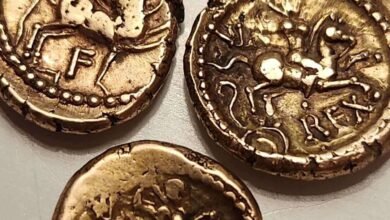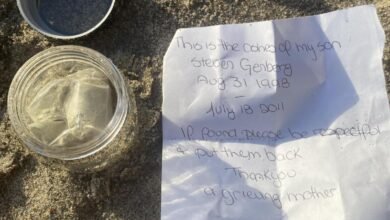Revealed: The best places in England to hunt for record-breaking treasure

They have lain undisturbed for hundreds, sometimes thousands of years. Intricate items, often made of valuable materials such as gold and silver, that were buried, discarded, or even accidentally left behind.
However, thanks to the ever-increasing number of metal detectors, treasures are now being unearthed across the UK on an unprecedented scale, offering finders a potential reward while giving experts better archaeological knowledge.
Figures released by the British Museum show there were a record 1,378 cases of reported treasures in England, Wales and Northern Ireland in 2022.
Under the Treasury Act, all finds must be reported, and if confirmed, museums are allowed to purchase the items at market value. The money is then split between the finder and the landowner.
Data released by the museum this week also revealed the areas where the most treasure finds were reported, with Norfolk recording the highest number with 95 finds, followed by Hampshire with 83 and Kent with 81.
Most of the finds recorded by the museum’s Portable Antiquities Scheme (PAS) were discovered by metal detectorists and mud detectors, people who search muddy river banks for artifacts.
Among the discoveries was a hoard of three gold bracelets dating to between 1500 and 1100 BC. 500 BC, which were accidentally found during a metal detecting rally near Malmesbury. The decorations on them helped expand knowledge of metalworking during this period.
Additionally, a medieval rosary bead carved from bone, possibly depicting the Virgin Mary, was found on the banks of the River Thames by Mudlarker Caroline Nunnely.
In Staffordshire, a metal detector discovered a 3,000-year-old Irish-made gold garment clasp, showing early cultural connections beyond the Irish Sea. The dress clasp found by Jonathan Needham is one of only seven discovered in England and Wales.
In its report, the British Museum said the increase in treasure finds, which were among the 53,490 archaeological discoveries in 2022, was making a “huge contribution” to expanding archaeological knowledge in the UK.
It said: “Most of the items were found by metal detectorists and most of the finds were made on farmland where they might otherwise be lost to plowing.”
Sir Mark Jones, interim director of the British Museum, added: “Information about finds is recorded by the PAS to increase knowledge about ancient peoples, where and how they lived.
“As such, it reflects every part of human history, from the Palaeolithic to modern times, across England and Wales. Most of the recorded finds were found by members of the metal detecting community and I would particularly like to thank them for recording these items with the PAS.”
Sir Mark also called on metal detectorists to take responsibility; Obtaining permission from landowners and reporting finds.
While the National Council for Metal Detecting has reported a 10 percent increase in membership to over 300,000 members by 2021, problems with rogue detectorists remain, as reports of “nighthawkers” looting ancient sites after dark continue.
Five years ago, police increased patrols along Hadrian’s Wall after illegal metal detectors were spotted at work in the area.



